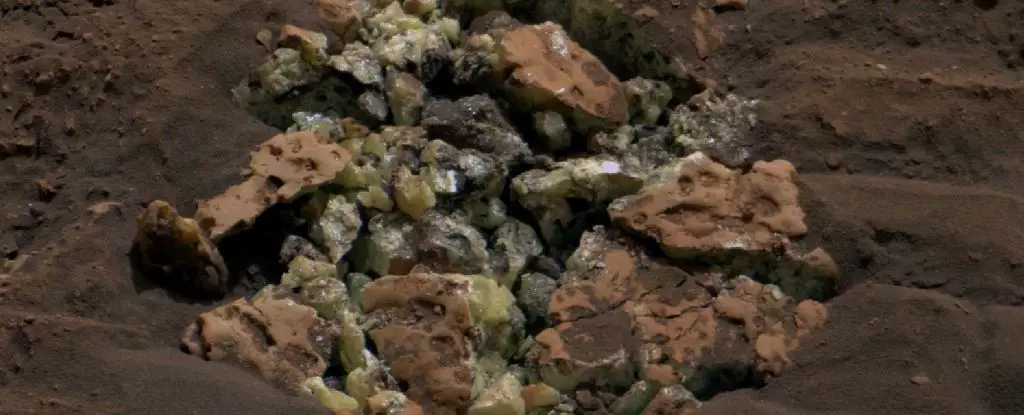In a remarkable twist of fate, the Mars rover Curiosity stumbled upon an astonishing discovery that has intrigued scientists and space enthusiasts alike. While traversing the rocky terrain of the Gediz Vallis Channel, the rover’s considerable weight inadvertently fractured an unassuming rock, unveiling a hidden treasure of yellow crystals made of pure elemental sulfur. This unexpected event not only broadened the scope of Martian exploration but also tantalized researchers with the implications of this find, marking it as the first instance of sulfur identified in its pure form on the red planet.
Sulfur is a crucial element for life, primarily appearing in compound forms such as sulfates, which result from the interplay of sulfur, water, and various minerals. Earth’s biochemistry heavily relies on this element, particularly for the synthesis of essential amino acids in living organisms. The discovery of pure elemental sulfur in the Gediz Vallis Channel challenges existing theories about Mars’ historical geology and its capacity to support life.
While sulfates have been previously detected on Mars, representing the planet’s geochemical processes, the presence of elemental sulfur raises questions about the conditions required for its formation. On Earth, much of the sulfur that exists is influenced by biological processes and is commonly found in compound forms due to the presence of liquid water, which has subsequently evaporated. Mars, however, is widely regarded as having a much drier history, making the existence of elemental sulfur not just surprising but an anomaly that needs further investigation.
The Gediz Vallis Channel, a site rich in geological history, suggests ancient waterways where liquid water may have once flowed. As Curiosity analyzes this captivating landscape, it has revealed not only the unexpected sulfur but also rock formations that resemble the sulfur-rich specimen that the rover fortuitously cracked open. This begs the question: is elemental sulfur more prevalent than previously thought, and how did it come to reside in a martian environment characterized by aridity?
Planetary scientists are now contemplating the geological evolution of Mars, considering various processes that could lead to the accumulation of pure sulfur. The unique conditions needed for its formation might indicate previously unrecognized phenomena that shaped the Martian surface. Investigating the origins of this sulfur will require modeling Mars’ geological evolution alongside new analytical techniques, allowing for enhanced understanding and discovery.
While the excitement of this discovery ignites the scientific community, it serves as a reminder of how much there is still to learn about Mars. Curiosity is equipped with an array of scientific instruments poised to uncover further secrets, yet it operates under significant limitations due to the vast distance from Earth. Thankfully, with mobile capabilities, it can sample a variety of rocks and terrains that may possess additional surprises, each with their own contributions to the story of Mars.
The Gediz Vallis Channel serves as a potential treasure trove of geological history. As Curiosity continues its mission, scientists are eager to see what other enigmatic features may lie beyond the horizon. Beyond sulfur, the rover is tasked with searching for signs of previous environments that could have been hospitable for microbial life, further compounding the significance of its work on the red planet.
Curiosity’s journey has reignited the debate over Mars’ potential to host life in some form. Despite the lack of any confirmed life forms, the remnants of chemistry, water history, and the conditions necessary for life hint that Mars could have had a more dynamic past than previously imagined. Each sample and every analysis adds to the growing understanding of the planet and offers more context for the elemental sulfur find.
The discovery of pure elemental sulfur is a monumental step in unraveling the complexities of Mars’ geological history. It challenges established norms while simultaneously guiding future exploration. The excitement that emanates from such a finding is emblematic of the exploratory spirit driving scientists to uncover the mysteries of the cosmos, reigniting the quest for knowledge about our neighboring planets and the fundamental processes that govern the formation of planetary bodies. As Curiosity continues to venture deeper into Martian terrain, one can only wonder what other wonders await discovery on this alien landscape.

